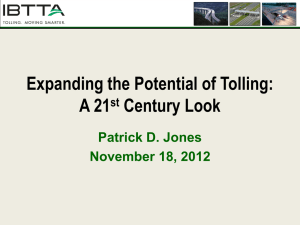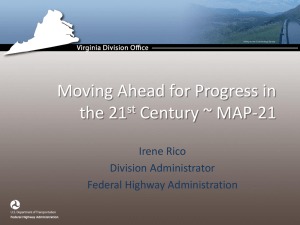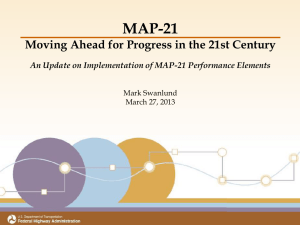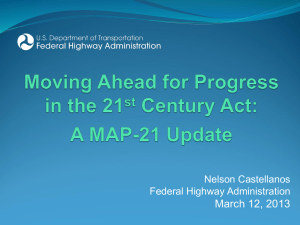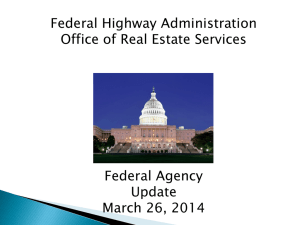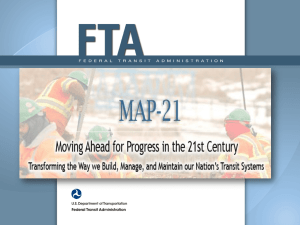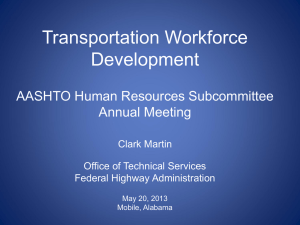Communications Update the Minnesota
advertisement
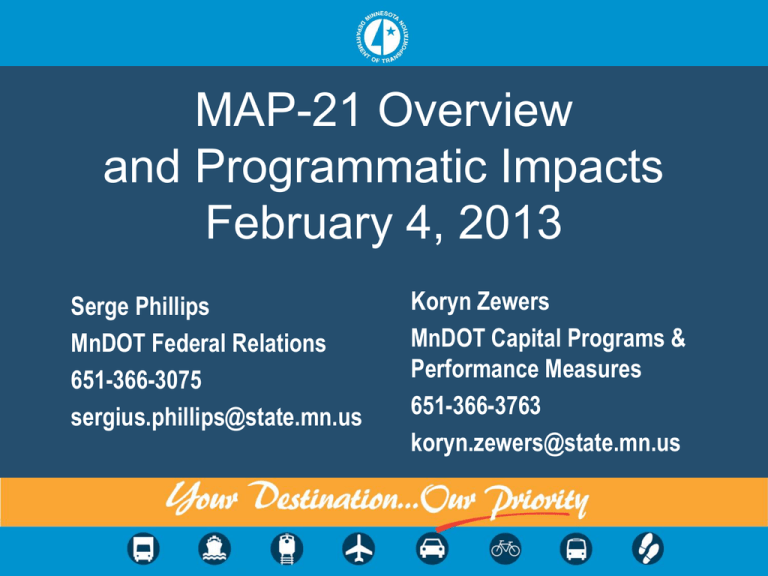
MAP-21 Overview and Programmatic Impacts February 4, 2013 Serge Phillips MnDOT Federal Relations 651-366-3075 sergius.phillips@state.mn.us Koryn Zewers MnDOT Capital Programs & Performance Measures 651-366-3763 koryn.zewers@state.mn.us Moving Ahead for Progress in the 21st Century (MAP-21) – Surface Transportation Reauthorization Bill Federal Funding Terminology • Authorization Acts – upper limit on program funding • Apportionment – statutory formula funding terms • Appropriations Acts – annual funding with specific funding amounts • Obligation Authority – annual funding amount released by federal aid highway program SAFETEA-LU & MAP-21– Highway Themes • SAFETEA-LU (2005-2009+): Earmarks, Equity Bonus, separate highway safety program, State received program by program apportionment -MN highway obligation authority - $525 M/yr • MAP-21 (2012-2014):Performance-based Investment, National Highway System focus, formula program consolidation and changes -(Est.) MN highway obligation authority - $575 M/yr MAP-21 Programs National Highway Performance Program (NHPP) Surface Transportation Program (STP) Highway Safety Improvement Program (HSIP) Congestion Mitigation and Air Quality (CMAQ) Metropolitan Planning SAFETEA-LU Programs Interstate Maintenance, Bridge, National Highway System STP (less Enhancements), Off-System Bridges, Coordinated Border FY 2012 FY 2013 $308 $365 $180 $168 HSIP, Rail $35 $40 CMAQ $32 $31 $4 $4 Transportation Alternatives (TA) Metropolitan Planning Safe Routes to Schools, Recreational Trails, Enhancements, Other TA $24 $17 N/A Equity Bonus $42 $0 $625 $625 Total Apportionment MAP-21 Highway Formula Program Consolidation • National Highway Performance Program (NHPP) • 63.7% of Minnesota’s total Federal Aid Apportionment • Approximately $57 million in additional annual apportionment compared to previous programs • Performance Driven Investment: US DOT will establish national measures and Interstate performance targets, NHS performance targets established by each state • Matching requirements remain • Ability to transfer up to 50% of NHPP MAP-21 Highway Formula Program Consolidation • Surface Transportation Program (STP) - primary federal funding source for projects not on NHS • Transit Capital included • 29.3% of Minnesota’s total Federal Aid Apportionment • Minnesota’s STP apportionment is $12 million/yr less compared to FY2012 • Funding formula has changed: – MAP-21: 50% to any area of the state; 50% based on population – SAFETEA-LU: 37.5% to any area of the state; 62.5% based on population MAP-21 Highway Formula Program Consolidation • Highway Safety Improvement Program (HSIP): Increased funding levels ($ 5M/yr) and continued focus on ALL public roads • CMAQ and Metropolitan Planning: similar apportionment • Transportation Alternatives Program (TAP) – Funding for Enhancements, Safe Routes to Schools, Recreational Trails, and other similar transportation projects – $16.5 million in apportionment for FY 2013. $7 million less than SAFETEA-LU – One set-aside: $2.2 million for Recreational Trails – Competitive grant process Performance Management Provisions • MAP-21 connects transportation investments to performance-based outcomes ◦New national goals establish outcomes ◦National performance measures establish criteria for measuring progress ◦State targets will measure progress toward goals MAP-21 Tribal Transportation • The Indian Reservation Roads (IRR) Program changed to Tribal Transportation Program (TTP) • MAP-21 replaces previous formula funding, resulting in funding reductions to Minnesota tribes – 27% based on a tribe’s relative share of road miles – 39% based on a tribe’s relative share of HUD Indian housing population (self-identified) – 34% based on a tribe’s share of RNDF and population adjustment factor funding from FY2005 to FY2012 MAP-21 Freight Provisions • Increased freight policy and planning focus – Freight Performance Requirements: truck travel time and reliability on Interstate highways – Designation of National Freight Network will drive future freight funding and priorities – US DOT required to develop a National Freight Strategic Plan MAP-21 Alternative Finance Provisions • TIFIA: $1.7 billion in funding for credit assistance to projects of national or regional significance • Tolling: MAP-21 expands state ability to use tolling: – to expand Interstate capacity – Federal Value Pricing Pilot Program (MN one of 15 states involved) – all electronic toll facilities must be interoperable by Oct. 1, 2016 Accelerated Project Delivery Emphasis • Accelerated Project Delivery: – Authority for activities prior to completion of NEPA, including acquisition of real property – Authority to enter into CM/GC contract • Environmental Streamlining: permits programmatic approaches for environmental reviews and mitigation plans – Additional Categorical Exclusions • Agency Coordination: accelerated decision-making (combined FEIS and ROD), emphasis on early interagency coordination and a new issue resolution process MAP-21– Transit Themes • Highway/ Transit - 80/20 funding split retained • Consolidation of major formula programs • New Freedom program replaced by Enhanced Mobility of Seniors and Individuals with Disabilities • New asset management requirements • Performance-based planning requirements aligning federal funding with national goals and progress towards these goals MAP-21 Urban Transit Highlights • Urbanized area transit formula funding – gets $54.5 M/yr for new uses such as transit capital and preventive maintenance • Fixed Guideway Capital Investment Grants replaces New Starts/Small Starts Programs with new eligibility for core capacity projects • New State of Good Repair Program. Two categories of funding ($11.3 M/yr) – High Intensity Fixed Guideway formula for rail and BRT on exclusive guideways – High Intensity Motorbus formula for buses that run in HOV lanes or shoulders MAP-21 Rural Transit Highlights ∙ Non-urbanized formula funding. Job Access/Reverse Commute now eligible ∙ Enhanced Mobility of Seniors and Individuals with Disabilities apportions funding to both states and large urbanized areas (>200,000) ∙ Although federal formula funding to Greater Minnesota transit increased, other program changes reduced key greater MN transit bus funding streams MAP-21 Highway Investment Programming Challenges ∙ Same amount of highway funding, but apportioned differently ∙ MAP-21 emphasis on Performance-based Investment and NHS focus: ∙ Interstate pavements at 2% poor (national standard) ∙ NHS pavements at 3% poor (proposed state target) ∙ Bridges with less than 10% structural deficiency (MAP-21) ∙ MAP-21 flexibility to transfer funds between six core formula highway programs ∙ Alignment of four year highway plan (STIP) with MAP-21 provisions • Four-year plan published in the late fall/early winter each year • Includes all projects using federal funds provided through FHWA as well as other regionally significant highway projects • Organized by region of the state and by year • Must be fiscally constrained • Area Transportation Partnerships (ATPs) involved throughout the STIP development process • Sub-state, multi-county partnerships • Include traditional and non-traditional transportation partners • Role is to integrate regional transportation priorities into the programming process • Solicit and review projects that are eligible for federal funding within their region Under Programmed $200.0 $150.0 $100.0 $50.0 NHPP STP HSIP CMAQ $(50.0) FY 2013 FY 2014 FY 2015 FY 2016 TAP Over ___ $- Goal: Move toward all MAP-21 performance goals, additional funding for Transportation Alternatives, and maintain the current program: • Most projects in years FY 2014-2016 will be funded • $186 million for new interstate and national highway system pavements • $60 million for new metro reliability projects • $27 million for new highway safety projects • $20 million for new transportation alternative projects • • • Funding Sources for Additional Projects: $188 million in federal funds above forecast $105 million in project shifts Federal fiscal yearforecast ∙ Statewide Performance Program ($400M) ∙ Interstate pavements and NHS bridges ∙ NHS system performance ∙ District Flexible Program for managing the Districts’ highest priorities ($320M) ∙ Funding directed by Area Transportation Partnerships ($134M) ∙ Transition to MAP-21 programs and funding in FY 2014-2016 ∙ New target formula beginning in FY 2017 ∙ Increased emphasis on aligning spending with specific performance measures ∙ Increased emphasis on statewide programs ∙ Continued involvement of Area Transportation Partnerships (ATPs) ∙ Minnesota GO ∙ Minnesota State Highway Investment Plan (MnSHIP)
